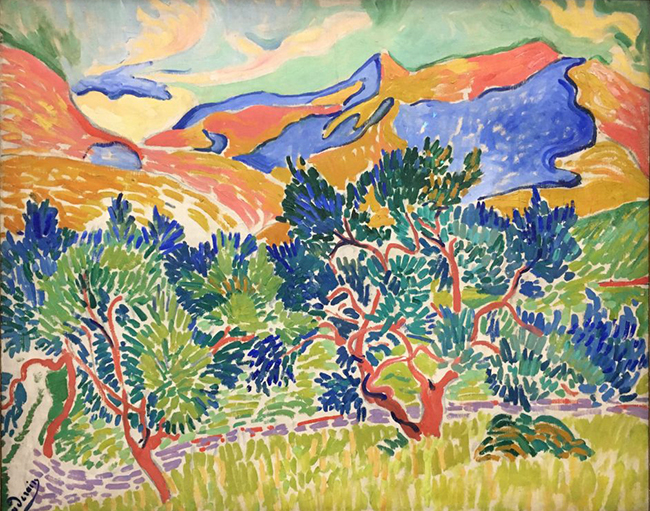What is Fauvism?
When I comes to define Fauvism art, this fauvism art movement was definitely a revolutionary art movement. It burst onto the scene in the early 20th century which flourished in France, leaving an indelible mark on the canvas of art history. Defined by its audacious use of color and expressive freedom, Fauvism challenged the norms of traditional art, creating a vibrant and dynamic movement that would reshape artistic perspectives.
Origins and Characteristics
The Fauvism movement originated in the early 1900s as a response to the prevalent artistic styles of the time, such as Impressionism and Post-Impressionism. Artists associated with Fauvism sought to break free from the constraints of realistic color representation and instead embraced a wild and unrestrained approach to color. The term “Fauve,” meaning wild beast in French, encapsulates the movement’s bold and untamed spirit. The painters in Fauvism painted directly from nature just like impressionists but their portrayal of subjects was very expressive and very bold colors and strokes were used.
Understanding Fauvist Paintings
At the heart of Fauvism lies a profound appreciation for color as a means of expression. Fauvist paintings, often referred to as fauve artwork, are characterized by their vivid, non-naturalistic colors and dynamic compositions. Artists engaged with unconventional color choices, using bold and contrasting hues to convey intense emotions and create a powerful visual impact.
Key Artists of Fauvism
The leading figures in the artist of Fauvism include the visionary Henri Matisse, widely regarded as the father of Fauvism, and André Derain. Matisse’s groundbreaking work, such as “Woman with a Hat” (1905), exemplifies the movement’s principles, showcasing a departure from traditional representation and a bold exploration of color’s emotional resonance.
Henri Matisse: The Visionary Father of Fauvism
Henri Matisse, often hailed as the father of Fauvism, stands as a towering figure in the annals of art history. Born in 1869, Matisse’s artistic journey took a revolutionary turn with his pivotal role in the emergence of the Fauvist movement.
Early Life and Influences
Matisse’s artistic journey began at a young age, studying law initially but soon discovering his true passion for art. His encounters with the works of Post-Impressionist masters, such as Paul Cézanne and Vincent van Gogh, set the stage for his departure from conventional artistic norms. He experimented with post-impressionist approaches to arrive at Fauvism art style.
“Woman with a Hat” (1905): A Fauvist Masterpiece
In the watershed moment of Fauvism’s inception, Matisse unveiled “Woman with a Hat” in 1905 at the Salon d’Automne in Paris. This painting, now an iconic example of Fauvist brilliance, marked a radical departure from traditional representation. The vibrant and arbitrary colors used to depict his wife’s portrait stunned the art world and defined the core principles of the Fauvist movement.
André Derain: A Fauvist Pioneer
Alongside Matisse, André Derain played a crucial role in shaping the Fauvist movement. Born in 1880, Derain’s artistic journey paralleled Matisse’s, and the two artists collaborated closely during the formative years of Fauvism.
Collaborations with Matisse
Derain’s collaboration with Matisse was instrumental in defining the Fauvist style. Their paintings, often exhibited together, shared the movement’s key characteristics, including vivid colors, dynamic compositions, and a rejection of realistic representation. “Charing Cross Bridge” (1906) is a notable example of Derain’s Fauvist brilliance, capturing the energy of London with bold strokes and unconventional colors.
Fauvism to Traditionalism
While Derain was a prominent Fauvist, he later distanced himself from the movement as it waned in the art scene. Derain moved towards a more traditional and classical style, embracing a return to a more representational approach.
Decoding Fauvism: Techniques and Characteristics
Fauvism Art Techniques
Fauvist artists employed unique Fauvism art techniques, focusing on color as a primary vehicle for conveying emotion. Brushstrokes were expressive and spontaneous, capturing the immediate energy of the artistic process. The use of unconventional colors and the distortion of forms were characteristic elements that set Fauvism apart from its contemporaries.
Main Characteristics of Fauvism
The characteristics of Fauvism art are marked by its vibrant color palette, expressive brushwork, and a deliberate departure from realistic representation. Fauvism thrived on the idea that art should evoke emotion independently of form, emphasizing the subjective experience of the artist and the viewer alike.
The Essence of Fauvism Explored
What is the Main Idea of Fauvism?
The main idea of Fauvism revolves around the liberation of color from its conventional role. Fauvist artists sought to convey emotion through color rather than replicating the natural world accurately. The movement rejected the notion that art should imitate reality, opting instead for a subjective and emotionally charged approach.
Legacy and Later Developments
Though Fauvism as a distinct movement lasted only a short span from 1905 to 1908, its impact reverberated through subsequent art movements. Fauvism’s influence can be traced in the works of later artists, including German Expressionists and American Abstract Expressionists, marking a significant shift in the trajectory of modern art. Later many of the painters rejected the turbulent emotions and brushstrokes of Fauvism and shifted to more logical approach of Cubism.
Conclusion: Fauvism in Full Spectrum
In conclusion, Fauvism stands as a testament to the unrestrained power of color and the boundless freedom of artistic expression. The movement, spearheaded by Henri Matisse and other notable artists, disrupted artistic conventions and paved the way for a new era of vibrant, emotionally charged artwork. Fauvism’s legacy endures as a celebration of color’s autonomy and its ability to evoke profound emotions. For those captivated by the bold strokes and untamed palette of Fauvism, the journey into this wild and captivating art movement is an exploration of boundless creativity and the relentless pursuit of artistic freedom.

%20by%20Matisse.jpeg)
%20by%20derain.png)